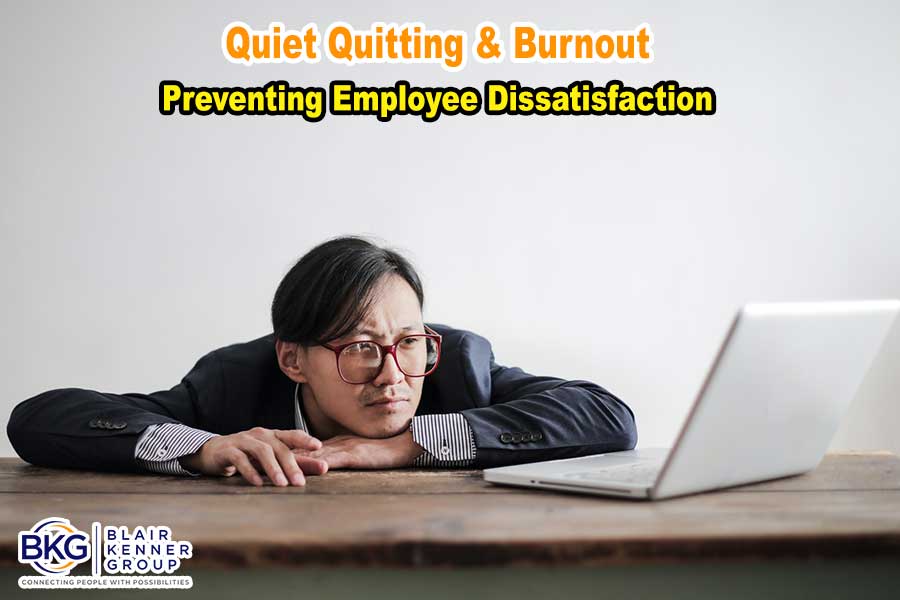
If you’ve perused LinkedIn, opened Facebook, watched the news…or had any interfacing with the internet recently, you’ve likely seen the words “quiet quitting” and “burnout” dance across your screen. Everyone from NPR to Tik Tok stars have commented on the phenomenon inspiring individuals to join the quiet quitting party and for employers to modify dated workplace practices. Many have coined it the new “Gen-Z” trend, others have gone so far as to state it’s just an excuse to be lazy at work, and some feel it’s a long-time coming workplace revolution. So, which is it? Let’s get down to brass tacks.
Quiet quitting is not the traditional saying goodbye to one’s job. The all-knowing dictionary.com breaks the term down as, “an informal term for the practice of reducing the amount of effort one devotes to one’s job, such as by stopping the completion of any tasks not explicitly stated in the job description. The term implies that this is done secretly or without notifying one’s boss or manager.”
The urge to quiet quit doesn’t just arise overnight — what we are truly talking about here is the manifestation of workplace burnout. Psychology Today tells us burnout is “a state of emotional, mental, and often physical exhaustion brought on by prolonged or repeated stress.” Day-in, day-out participation in a workplace with a culture that does not support a healthy work-life balance is a one-way ticket to burnout central.
While the phrase quiet quitting may seem like a newly coined phenomenon, workplace burnout is hardly a new concept. The term quiet quitting entails self-preservation efforts such as only performing at one’s paygrade, leaving work at the office, and simply meeting minimum job requirements. It’s an employee initiating boundaries within their workplace while still meeting the terms of their employment. To put it simply, it’s doing what they must do to keep their jobs, while decreasing their stress intake.
Quiet quitting and burnout are no strangers to the worker’s compensation and insurance spaces. We see this evidenced by the critical gap in talent and the rapidly changing industry landscape! At this juncture you may be thinking, well this is all wonderful information….but now what? Here at BKG, we understand preventing workplace burnout and curbing quiet quitting begins with talent acquisition firms during the job placement process.
Preventing workplace burnout means garnering a thorough understanding of both client need and candidate expectation. We work collaboratively with our clients to obtain an elevated understanding of the workplace culture they promote. We explore questions including:
- How is the mental health of employees supported?
- What are the expectations for employee job performance?
- How are employees empowered to perform at their best?
- What career development opportunities are available?
Next, our talent acquisition specialists move through a series of interviews with each candidate to discover what they need from their workplace culture. During this phase of the talent acquisition process, we explore key candidate information such as:
- Does the candidate prefer remote work?
- Do they need a Friday off per month to attend their child’s baseball game?
- Is there a preference for a certain type of management style?
- What does work-life balance look like for this candidate?
With these questions answered, our insurance headhunters generate calculated, mutually satisfying client-candidate matches aimed to promote reciprocal wellbeing.
While preventing burnout and quiet quitting does begin with successful talent sourcing practices, it is critical employers continue to promote the vitality of their staff. A little effort goes a LONG way here! Here are BKG’s top 10 recommended burnout prevention practices:
- Compensation – provide your staff with commensurate compensation for their stellar work. Everyone’s here to earn a living!
- Boundaries – this is a two-way employer-employee street! Respect and normalize the need for personal time and space. This can be as simple as emphasizing answering emails after-hours is optional.
- Connection – weekly 1:1’s with your employees are an incredible tool for checking-in and motivating your staff.
- Modeling – radiate the energy you want to see from your employees! Empowered people, empower people.
- Accountability – own up to opportunities for growth and follow through on exploring them. No one likes an empty promise.
- Career Coaching – combat disengagement by inspiring your employees to move forward in their career development! Promoting their growth is a win-win!
- Flexibility – we’re all human, we know things happen. Remaining flexible in the face of adversity is a sure way to keep your staff comfortable.
- Avoid Overworking – consistently evaluate deadlines and hour commitments. Ensuring realistic workloads for your team will promote overall happiness.
- Resources – offer spaces for your employees to seek assistance when needed. Whether is a mental health day or an extended break to attend a therapy appointment, we could all use the support!
- Show Gratitude – tell your employees how amazing they’re doing. It’s a cost-free way to make someone’s day!
